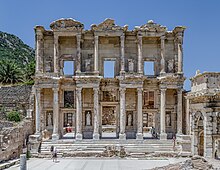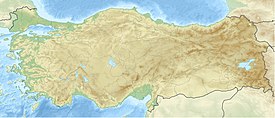Efes
- Tür: Ören Yeri, Antik Kent
- Tema: Arkeolojik Kazılar, UNESCO Dünya Mirası, Yedi Kilise
- Kültür: Antik Yunan, Bizans, Helenistik, İyon, Roma
- Bölge: Türkiye, Ege Bölgesi, İzmir, Selçuk
Ἔφεσος (Éphesos) Efes | |
 The Library of Celsus in Ephesus | |
| Location | Selçuk, İzmir Province, Turkey, West Asia |
|---|---|
| Region | Ionia |
| Coordinates | 37°56′28″N 27°20′31″E / 37.94111°N 27.34194°E |
| Type | Ancient Greek settlement |
| Part of | West Asia |
| Area | Wall circuit: 415 ha (1,030 acres) Occupied: 224 ha (550 acres) |
| History | |
| Builder | Attic and Ionian Greeks |
| Founded | 10th century BC |
| Abandoned | 15th century |
| Periods | Greek Dark Ages to Late Middle Ages |
| Site notes | |
| Excavation dates | 1863–1869, 1895 |
| Archaeologists | John Turtle Wood, Otto Benndorf |
| Website | www |
| Criteria | Cultural: iii, iv, vi |
| Reference | 1018 |
| Inscription | 2015 (39th Session) |
| Area | 662.62 ha |
| Buffer zone | 1,246.3 ha |
Ephesus (/ˈɛfɪsəs/;[1][2] Greek: Ἔφεσος, translit. Éphesos; Turkish: Efes; may ultimately derive from Hittite: 𒀀𒉺𒊭, romanized: Apaša) was a city in Ancient Greece[3][4] on the coast of Ionia, 3 kilometres (1.9 mi) southwest of present-day Selçuk in İzmir Province, Turkey. It was built in the 10th century BC on the site of Apasa, the former Arzawan capital,[5][6] by Attic and Ionian Greeks. During the Classical Greek era, it was one of twelve cities that were members of the Ionian League. The city came under the control of the Roman Republic in 129 BC.
The city was famous in its day for the nearby Temple of Artemis (completed around 550 BC), which has been designated one of the Seven Wonders of the Ancient World.[7] Its many monumental buildings included the Library of Celsus and a theatre capable of holding 24,000 spectators.[8]
Ephesus was a recipient city of one of the Pauline epistles and one of the seven churches of Asia addressed in the Book of Revelation.[9] The Gospel of John may have been written there,[10] and it was the site of several 5th-century Christian Councils (Council of Ephesus). The city was destroyed by the Goths in 263. Although it was afterwards rebuilt, its importance as a commercial centre declined as the harbour was slowly silted up by the Küçükmenderes River. In 614, it was partially destroyed by an earthquake.
Today, the ruins of Ephesus are a favourite international and local tourist attraction, being accessible from Adnan Menderes Airport and from the resort town Kuşadası. In 2015, the ruins were designated a UNESCO World Heritage Site.
- ^ "Ephesus Definition & Meaning | Dictionary.com".
- ^ Cite error: The named reference
Olausson2006was invoked but never defined (see the help page). - ^ Cite error: The named reference
Gagarin2010was invoked but never defined (see the help page). - ^ Cite error: The named reference
Ramirez-Faria2007was invoked but never defined (see the help page). - ^ Cite error: The named reference
BritishMuseumwas invoked but never defined (see the help page). - ^ Cite error: The named reference
SteadmanMcMahon2011was invoked but never defined (see the help page). - ^ "accessed September 14, 2007". Penelope.uchicago.edu. Retrieved 2009-04-20.
- ^ Ring, Trudy; Salkin, Robert (1995). "Ephesus". International Dictionary of Historic Places: Southern Europe. London: Fitzroy Dearborn. p. 217. ISBN 978-1-884964-02-2.
- ^ 2:1–7
- ^ Harris, Stephen L., Understanding the Bible, Palo Alto, Mayfield, 1985.






✶ İlgili Yerler
- Efes Celsus Kütüphanesi
- Efes Antik Tiyatrosu
- Efes Müzesi
- Efes Odeon
- Efes Liman Caddesi
- Efes Artemis Tapınağı
- Efes Yamaç Evler
- Efes Aşağı Agora
- Efes Hadrian Tapınağı
- Efes Varius Hamamı
- Efes Trajan Çeşmesi
- Efes Memmius Anıtı
- Efes Domitian Tapınağı
- Efes Devlet Agorası
- Efes Stadyumu
- Efes Vedius Gymnasiumu
- Efes Antik Limanı
- Efes Pollio Çeşmesi
- Efes Prytaneion
- Efes Mermer Cadde
- Efes Latrina
- Adamtolu Boğazı Su Kemeri
- Bahçecik Boğazı Su Kemeri
- Efes Doğu Gymnasium
- Efes Magnesia Kapısı
- Efes Anıt Mezar
- Efes Roma Çeşmesi
- Pollio Su Kemeri
- Efes Meryem Kilisesi
- Efes Oktagon Anıt Mezar
- Mil Taşları, Efes
- Efes Helenistik Çeşme Yapısı
- Efes Mazeus ve Mithridates Kapısı
- Efes Serapis Tapınağı

